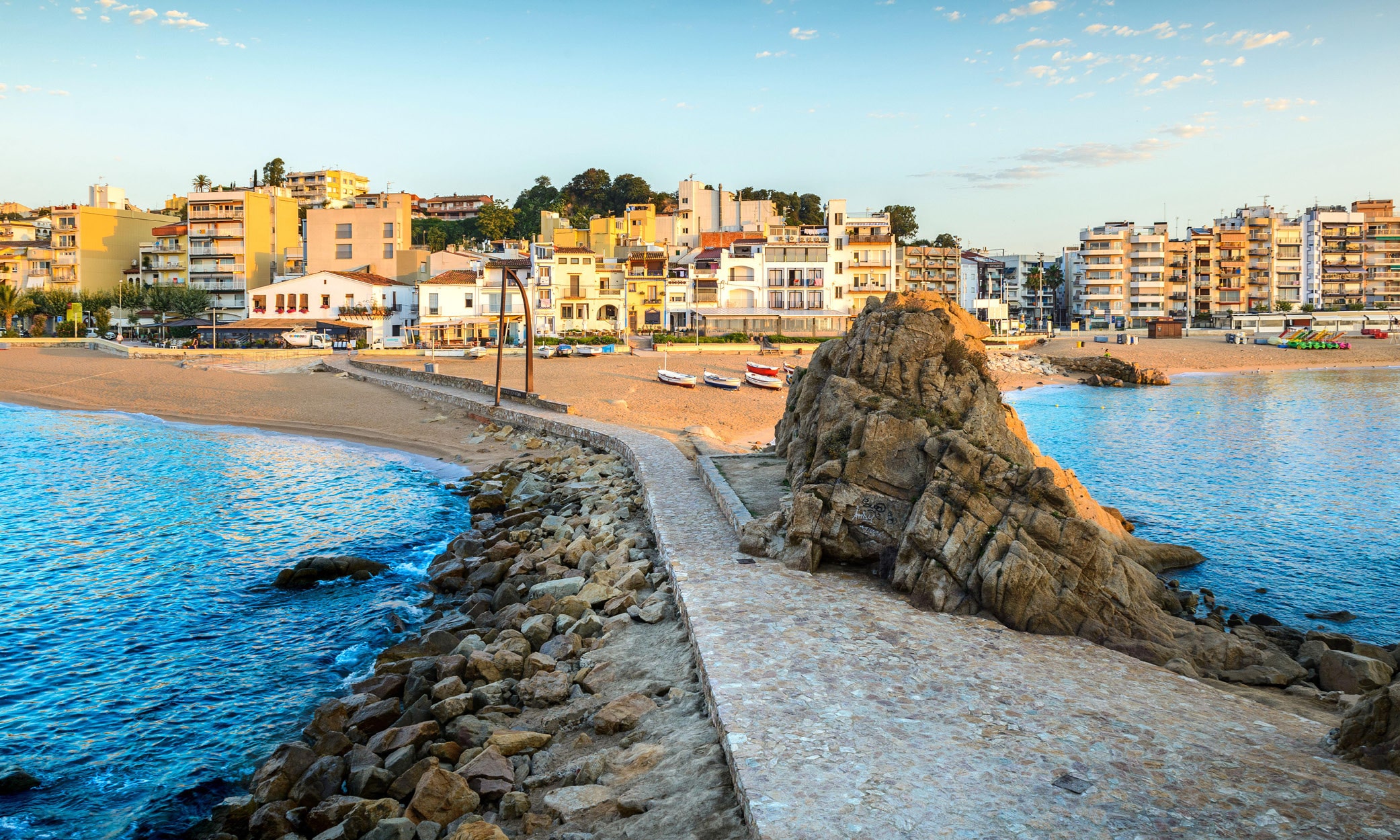
Did you know that Girona City was founded because of a “domestic” between some Romans? And that the founding Roman was not just any old Roman, but Pompey the Great. Well, he wasn’t “Great” yet at the time, but he gets the credit anyway. Of course, the Romans weren’t the first people here, though.
In the beginning, there was the word “Indiketes,” which kind of makes sense as that was the name given to the indigenous tribe that had already settled in the place where the city of Girona stands today. There were various spellings of the name, including Indigetes and Indĭgetæ, amongst others, but whatever the spelling, their given name could be translated as “indigenous” or “aboriginal.”
Because the Indiketes mostly populated lands closer to the coast and had their capital, “Indika” just outside where the medieval Catalan village of Ullastret is today, some local historians believe that site of today’s Girona city, being further inland, may have also been settled by another neighbouring Iberian tribe, the Ausetani, who gave their name to today’s comarca of Osona where they had their own capital, Vic.
Gerunda
Whoever was occupying the site made very little difference; however, once the Romans arrived, they began colonising the whole region and eventually the entire Iberian Peninsula. In fact, it was an internal Roman struggle for power that led to the foundation of Girona. Quintus Sertorius had been the Roman Governor of Hispania until 82 BCE but was a sworn enemy of Sulla, who was the Dictator of Rome at the time.
Sertorius formed a coalition with several of the indigenous Iberian tribes who had long resisted Roman rule but knew they could not defeat Rome alone, and so began the Sertorian War, which would rumble on for about eight years. Only a couple of years into the war, in 78 BCE, Sulla died. Shortly afterwards, the up-and-coming Gnaeus Pompeius Magnus, who would later go on to become Pompey the Great, was sent to Iberia by the Roman senate with over 30,000 soldiers to put an end to Sertorius’ rebellion.
One of his first acts on the peninsula was to build an almost triangular walled fortress, the first enclosure of what was to become the Roman city of Gerunda, as they called it in Latin. (This was the same Pompey, by the way, who eventually put down the Spartacus Rebellion soon afterwards.) Some parts of the original Roman walls are still there today.
The fortress, la Força Vella, to give it its Catalan name, remained unchanged until the 9th century, when it was expanded and the defences strengthened to withstand repeated sieges by Moorish invaders, thus also increasing Girona’s urban space. Further reconstruction occurred at the end of the medieval era in the late 14th to early 15th centuries. Built with sandstone, the walls have an impressive average height of 60m that varies by section and are almost 2km in total length. More on the medieval era anon.
Although it was not on the coast, the situation of Gerunda was of immense importance at the time as it was on the Via Heraclea (later renamed the Via Augusta), the only road at the time that connected the northeast of Iberia, through Narbonne in Gaul, to the Italian Peninsula, and was also well connected to the Roman port of Empùries. To really feel a sense of history, take a stroll along Carrer de la Força in the Old Town of Girona, and you’ll be walking along the old Via Augusta!
It is not known for certain, but one theory as to the origin of the name is that it derives from “Undarius”, the Latin name given to the River Onyar, one of the four rivers that converge at the city. (Another story goes that the city was named for the three-headed giant called Gério, who really founded the city – but more on legends later!)
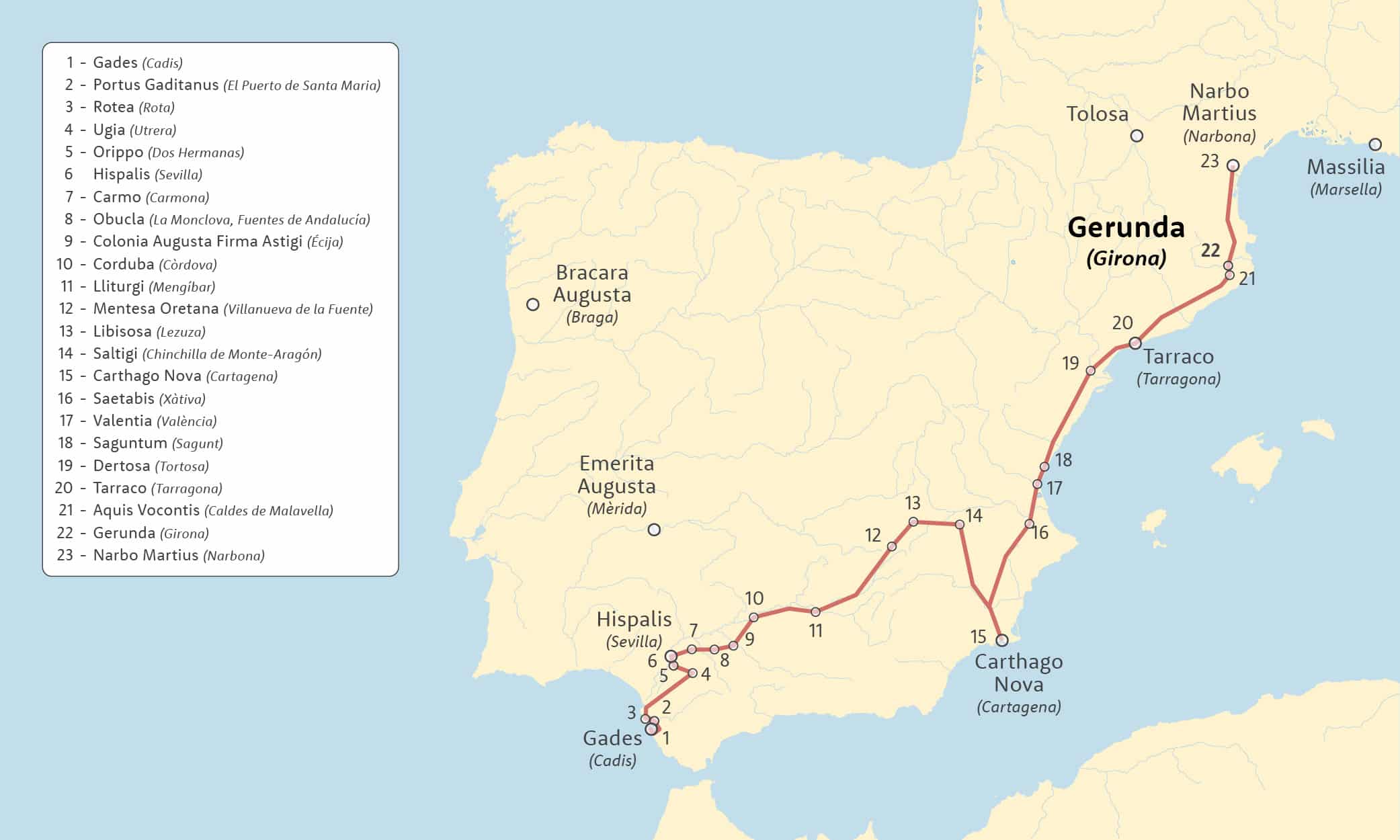
Christianity
Gerunda remained under Roman rule for the next few centuries, as with the rest of the Iberian Peninsula. During this time, Christianity spread gradually across Europe, eventually arriving in Girona around the early 300s. The first records of a Christian community in the city date back to 303, and although the Romans eventually adopted Christianity as the official religion of their empire, it happened just a little too late for poor Sant Feliu (Saint Felix), who became the first martyr of Girona in 307!
Although originally from near what had been Carthage in North Africa, Sant Feliu converted to Christianity while studying in Palestine and eventually made his way to Empùries and then Girona. The story of Sant Feliu’s execution has undoubtedly become exaggerated for effect over the centuries, as it makes for pretty grim reading!
He was supposedly first tortured and then tied behind a team of horses and dragged around the town – but his wounds miraculously healed themselves immediately. The story goes on to say that he then had a mill wheel tied around his neck and was thrown into the sea from a cliff at Els Guíxols, but was once again saved from death by miraculous divine intervention. Eventually, the sentence was carried out, and he died from having his skin and flesh stripped away with iron hooks. What a way to go!
Just a few years later, in 313, Emperor Constantine the Great issued an edict accepting Christianity, and another decade later, it became the official religion of the Roman Empire. After being canonised, the saint became known as St Feliu of Girona or St Feliu the African and today, quite a number of places are named for him, including St Feliu de Guíxols and St Feliu de Boada right here in El Baix Empordà, to name but two. His tomb is in the church in Girona that bears his name today: Basílica de Sant Feliu de Girona, just a stone’s throw from the Girona Cathedral.
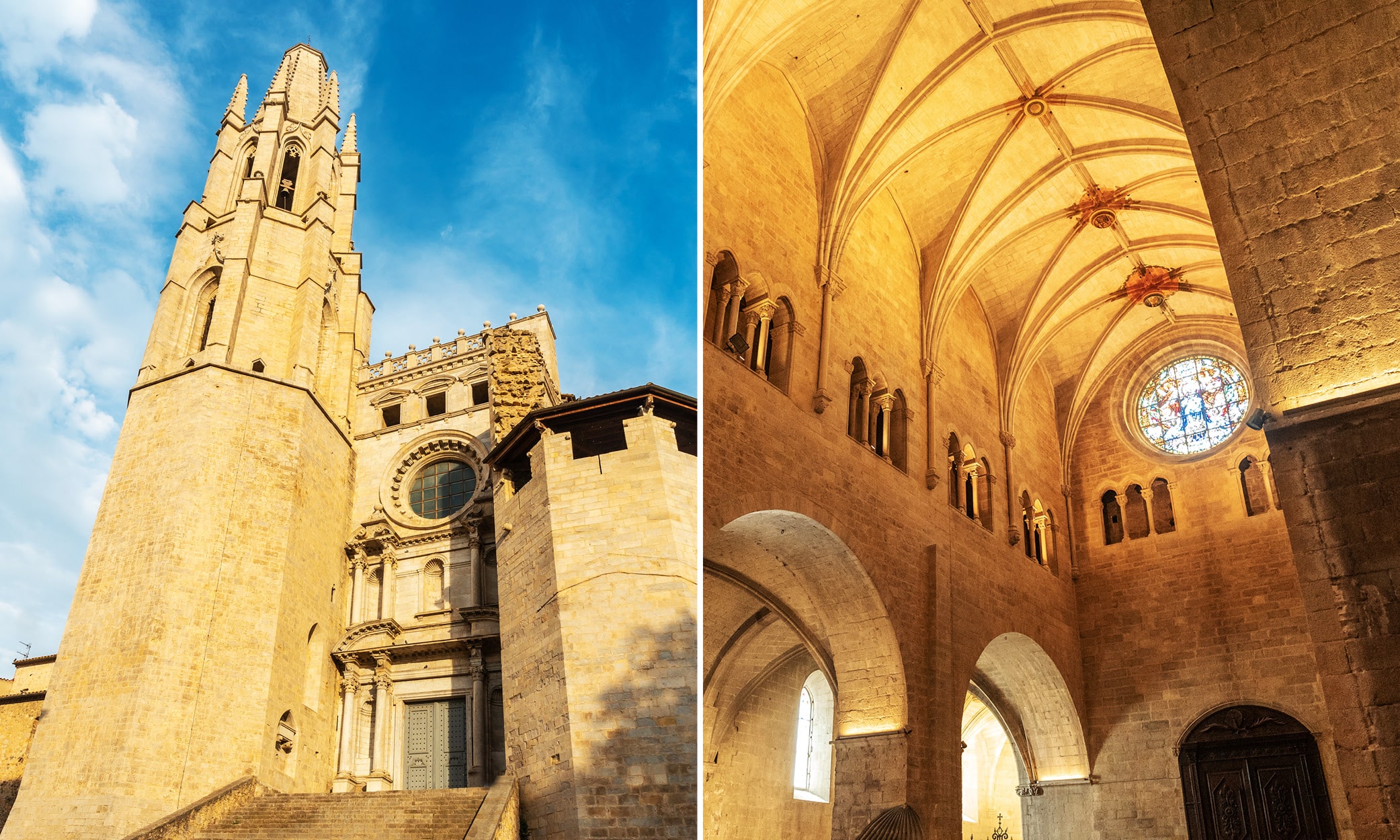
Turbulent times
Eventually, 600 years of Roman rule would come to an end, as all “good” things must. The Roman Empire had always had an uneasy relationship with the Germanic tribes to the north of its borders in Europe, and when large numbers of Germanic Goths entered Roman territory, fleeing Atila and his Huns, this served to weaken Rome from within.
What that meant for Girona was that Germanic tribes such as the Vandals and Suebi, and especially the Visigoths (one of the two main Gothic branches), began to move in and undermine Roman control of the region. Although many of the Visigoths converted to Christianity, the Romans still regarded them as barbarians.
Much Iberian territory changed hands on several occasions as Roman power weakened significantly until eventually, in the year 395, the Roman Empire itself split into two, Eastern and Western. Within less than a century, the Western Roman Empire collapsed and ceased to exist altogether in 480 AD. (The Eastern Roman Empire, with its capital in Constantinople, carried on for another millennium, becoming known later as Byzantium.)
Girona was now firmly in Visigoth hands, although the new masters gradually adopted the language, religion and much of the culture of their Hispano-Roman subjects, and under their rule, the longstanding practice of applying different laws for Romans and Visigoths was abolished. Not much of the history of the Visigoth era was actually recorded – although they did leave behind some churches – it was during the Visigoth era that the notion of Hispania as an entity, rather than merely a Roman province, really emerged for the first time.
Arab rule
Hispania may have begun to see itself as something like a nation for the first time, but in the 6th century, things were to change once again. In 711, the Moors began their conquest of Iberia, and by 715, Girona was in Muslim territory. The city put up little or no resistance to the invading Moors and so was spared any destruction. Although the Moors built a mosque and expropriated much of the property belonging to the Christian church – and probably had plans to do a lot more – they never really got a chance to leave a more permanent mark.
Unlike most of the rest of the Iberian Peninsula, Arab control over Girona only lasted 70 years. Being close to the edge of the Moorish-conquered lands and with the increasingly powerful Kingdom of the Franks (another Germanic tribe) just to the north, Girona was always vulnerable. The relative weakness of Muslim control in the region was further undermined by infighting amongst several Moorish factions, some of whom revolted against their own masters in 785 and offered their territories to Charlemagne, the King of the Franks, in return for military support.
Although the Moors briefly reclaimed Girona, laying siege to it in 793, and would sack it on five other occasions until they were finally driven out permanently, the city finally became the seat of the new County of Girona created by Charlemagne, with the Visigoth aristocracy ruling under the umbrella of the empire of their Frankish “cousins.”
For many historians, this County of Girona was the beginning of what would become Catalunya as an entity. For 16 years, Girona was the vanguard of Carolingian territory against Islam until Barcelona was also captured by the Franks and the Bishopric of Barcelona was established. Over time, Barcelona surpassed Girona in importance until Wilfred the Hairy eventually incorporated the County of Girona into the County of Barcelona in 878.
Nicknames
There used to be some great nicknames for monarchs in Europe back in those days! Apart from Wilfred the Hairy, there were also “Charles the Bald”, “Charles the Simple” and “Charles the Fat” – it seems sometimes there are just too many Charleses! The son of Charles the Fat was “Louis the Stammerer”, and another Louis was called “Louis the Slug”! Then there was also “Alfonso the Leprous”, “Pippin the Hunchback”, “Henry the Impotent”, not to mention “Raymond the One-Eyed”, “Ketil the Flatnose”, “Eric the Priest-hater”, “William the Bastard” and “James the Shit”! And there were many more. You certainly wouldn’t want to have been too thin-skinned being a king in those days…
Medieval Girona
From the 10th century on, the nobility of the County of Girona and the other Catalan counties gradually became more independent of their Frankish overlords and, in 987, broke with them completely. They were now de facto independent territories, effectively ruled by the Count of Barcelona, although not officially recognised. In 1137, the Count of Barcelona married the daughter of the King of Aragón, the neighbouring kingdom to the west, effectively creating the Crown of Aragón.
The following medieval period is considered to be the Golden Age of Girona, thanks in no small part to the Jewish community of the city. El Call, the Jewish Quarter, was effectively a city within a city, running itself largely independently and even had its own mayor. The Jewish Kabbalistic school in Girona was one of the main centres of learning in Europe for 600 years, but despite their positive influence, the Jewish population increasingly suffered from persecution until a pogrom against them in 1391 finally caused their population to decline significantly.
In 1469, another royal marriage took place between Queen Isabella of Castilla and King Fernando of Aragón (which included Girona), uniting their kingdoms and effectively creating for the first time something resembling what would become the country of Spain.
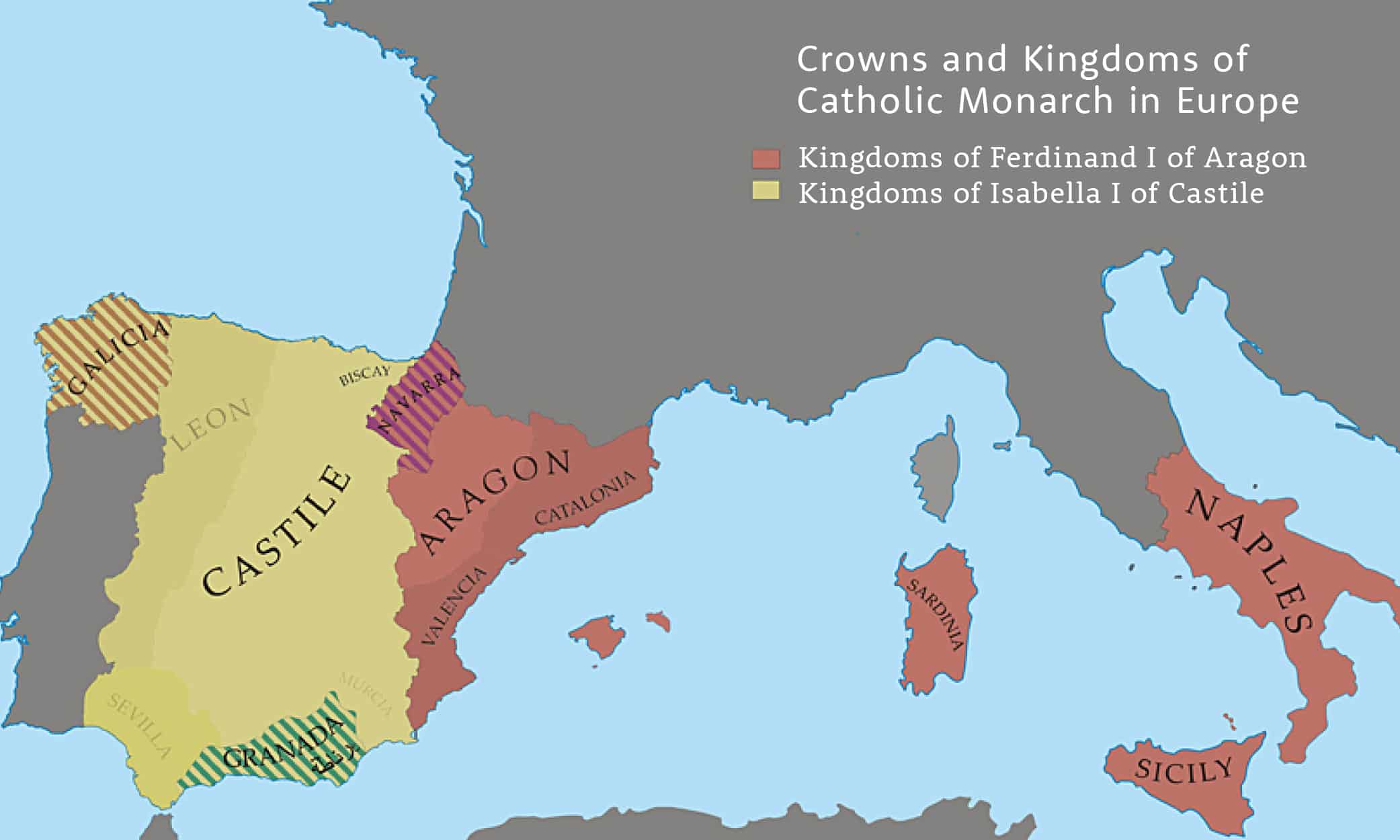
They came to be known as the Catholic Monarchs, and they weren’t too keen on any non-Catholics in their new realm. They set up the Spanish Inquisition and began expelling the last remaining Moors from Granada in the south of Spain, which they achieved in 1492, and they followed that up by expelling any Jews still in the country too. Any “infidels” who wished to remain were obliged to convert to Christianity. 1492 was also the year in which Columbus “discovered” the Americas, so the Catholic Monarchs had a lot going on that year!
Despite the expulsion of the Jews, Girona’s El Call district is one of the best-preserved Jewish Quarters in Europe today and is a major tourist attraction. The name comes from the street, which was the main artery of the Jewish Quarter, Carrer Major del Call, previously the Via Augusta and nowadays Carrer de la Força that we mentioned earlier. We told you it was historic! The last synagogue in the city today houses the Jewish History Museum, and just north of the old town and overlooking the city are the remains of the Castle of Montjuïc (“Hill of the Jews” in old Catalan), serving as another reminder of their past influence. A Jewish cemetery was also once located here.
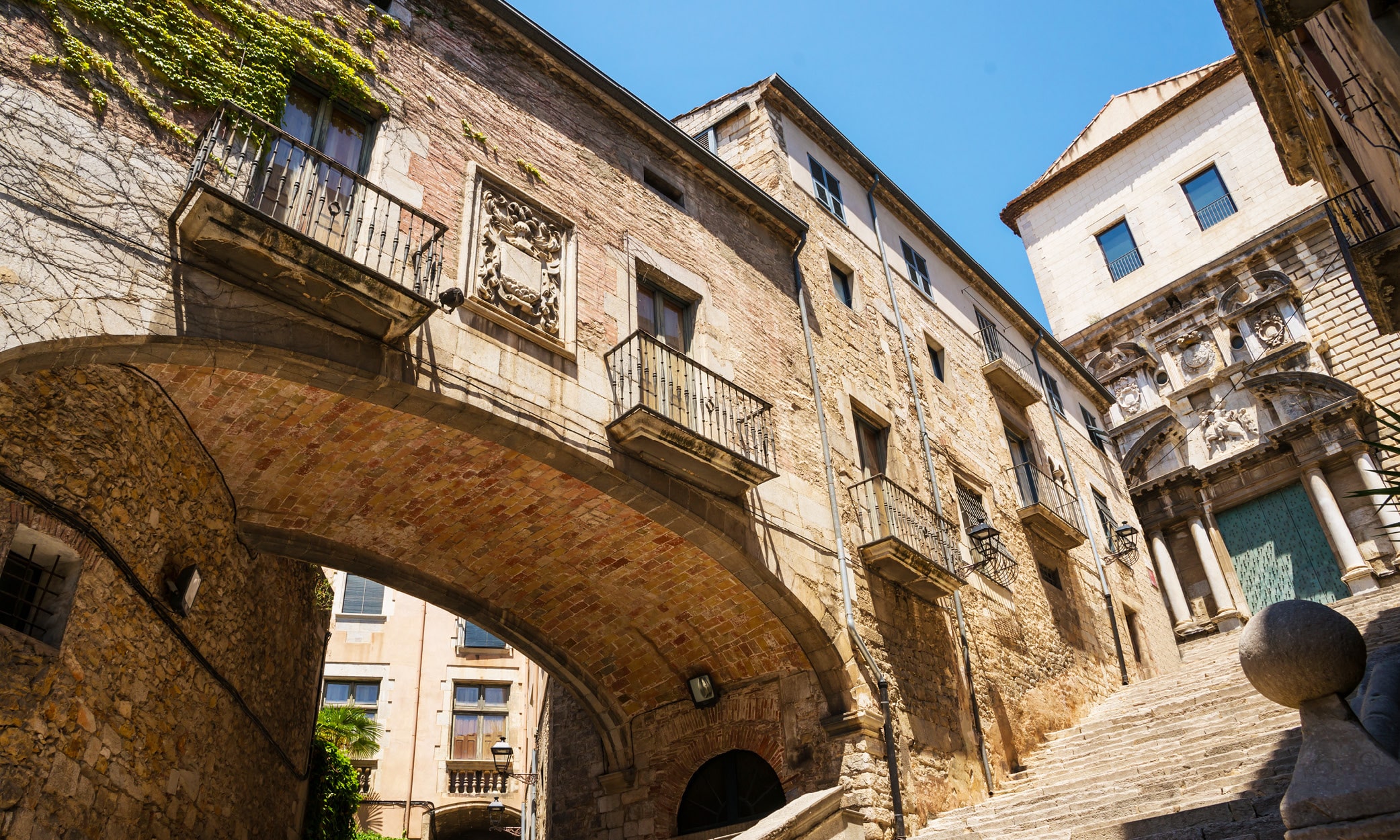
Girona city continued to grow over the following centuries with extensions and reinforcements of the city walls built to protect the city from attacks – and there were plenty of those, with Girona being laid siege to by French forces in 1653, 1684, 1694 and 1711 as part of greater European conflicts and then, finally, three times in 1808/9 by Napoleon. The city finally fell after the third of those sieges and remained under French control until 1813. The Plaça de la Independència was named for the defenders of Girona during those Napoleonic sieges and has nothing to do with the Independentista movement of recent years.
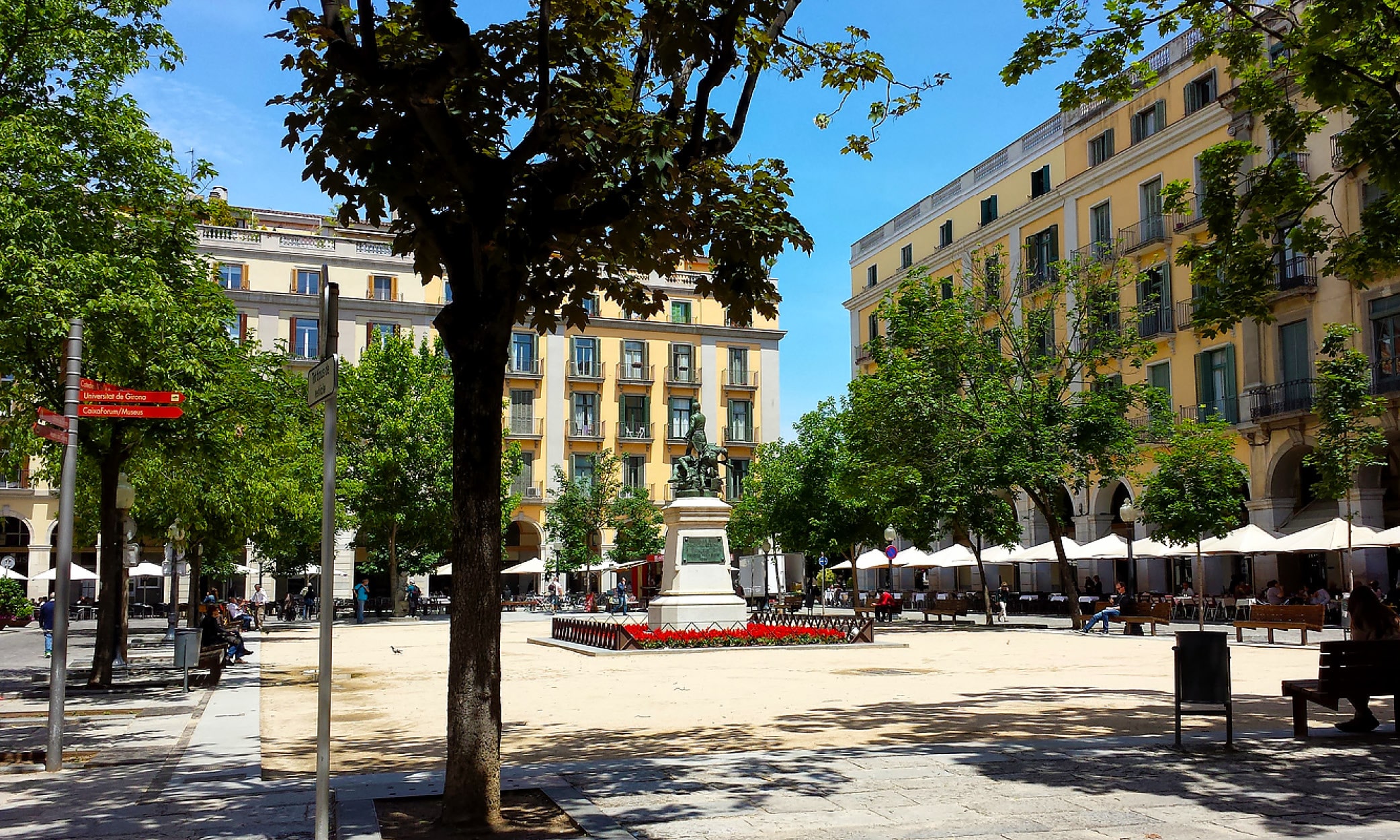
It should also be noted that the 17th century was a very complicated time within Europe, with a series of regional wars across just about the whole continent involving almost every important power of the time. These pan-European wars lasted 30 years and are collectively known as, well, “The Thirty Years War”! Within that war was the Franco-Spanish War, which lasted almost 25 years, and part of that war was the Catalan Reaper’s War, which went on for nearly 20 years.
On more than one occasion, when the French “invaded” Girona, they were actually doing so on the side of the Catalans against the Spanish. At other times, there was actually a three-way conflict between Catalans, Spanish, and French, and they all pitted against each other. As we said, these were complicated times!
Spanish Civil War and after
The era of the Industrial Revolution in the 1800s was a period of cultural renaissance in Catalunya, but war was to return to Girona once again when, following the fall of Barcelona to Franco’s army on 25 January 1939, towards the end of the Spanish Civil War, the nationalists entered Girona city just over a week later.
Under Franco’s rule, the Catalan language was banned, police and civil servants were brought in from elsewhere in Spain to maintain control, censorship was strict, and there was no political freedom. Even Girona’s name was officially changed to “Gerona” (in Castellano-Spanish), and it wasn’t until 1980 that it was officially changed back again.
Despite Franco’s oppressive government, Girona began to grow in the 1950s with increasing migration from other parts of Spain, and the city expanded, swallowing up some of the surrounding municipalities. After the end of the fascist regime, streets were returned to their original Catalan names, the university was founded, the economy prospered, and the average income rose, with Girona Province becoming the wealthiest in Spain. Today, it still remains a modest-sized city, though with a population of not much more than 100,000 inhabitants. In recent years, it has frequently ranked among the best places to live in all of Spain.
Modern times
Nowadays, Girona attracts many international tourists every year. It is connected by high-speed train routes to France and beyond, and has its own Girona-Costa Brava Airport. For many visitors, Girona offers the beauty of Barcelona but in a cleaner, safer and more manageable package. It has also become the gastronomic capital of the world, with its restaurants having won multiple global awards.
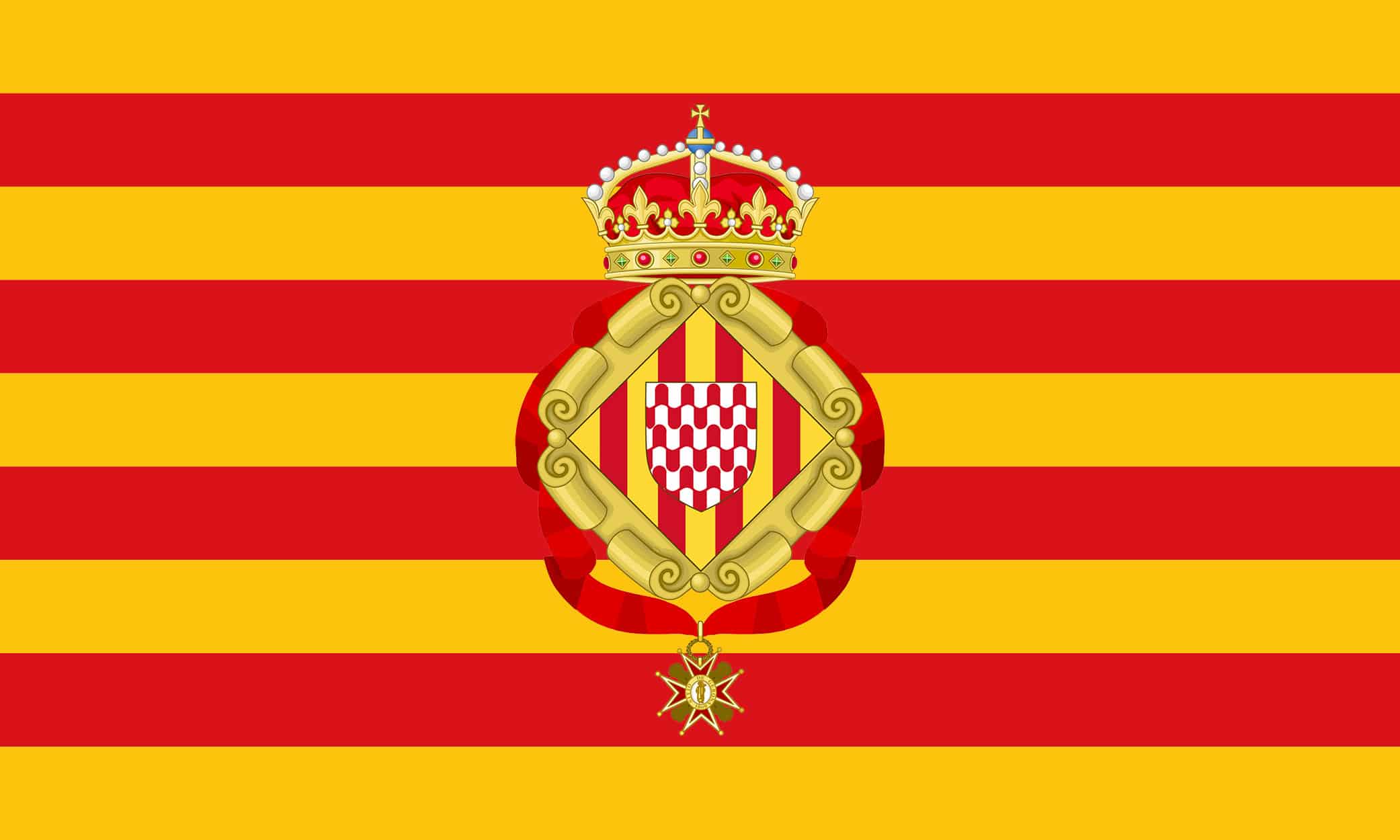
Some legends of Girona
In addition to its documented history, Girona city has numerous myths, legends, and tall tales, some of which have some basis in actual history, others a bit less so!
Charlemagne’s Chair
Inside Girona Cathedral, there is an ornate 11th-century throne known as Charlemagne’s chair. Legend has it that if a couple sits together on the throne, they will be wed within the year. By contrast, if a man sat on it on his own, he would never marry, and so some parents who wanted to have a priest in the family would have one of their male children sit on Charlemagne’s throne.
They also say that seminarians were forced to sit on the throne to keep “bad” thoughts out of their minds and remain pure in the priesthood. These myths must’ve had Charlemagne laughing to himself from beyond the grave as, first of all, he never actually set foot in Girona himself (the city was taken by his son, Louis), and secondly, as for being chaste, Charlemagne had eighteen children with eight of his ten known wives and/or concubines!!
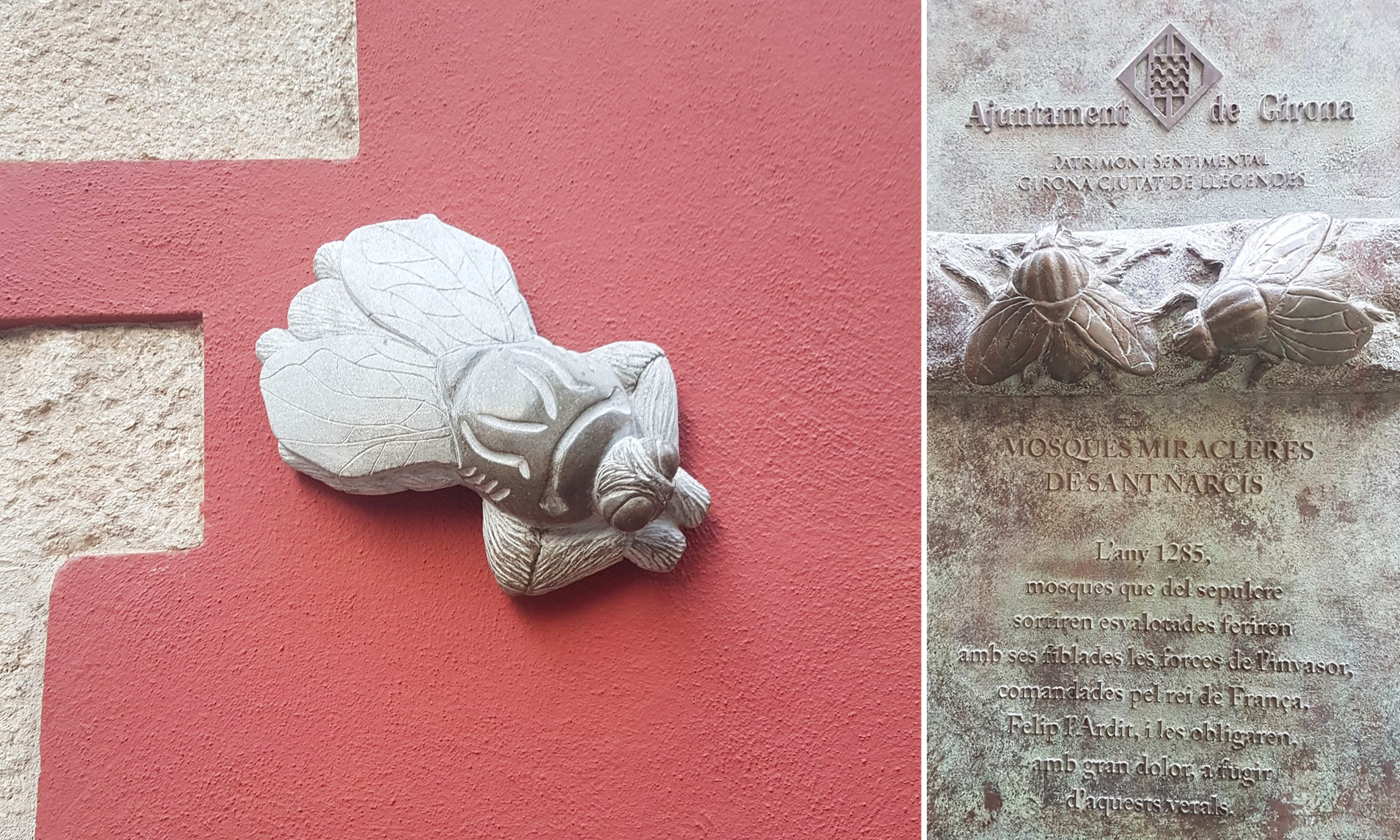
The Flies of St Narcis
Another legend of the city also concerns the French and one of their invasions that took place in September of 1285, when some of King Philippe the Bold’s soldiers allegedly desecrated the tomb of Sant Narcis, the patron saint of Girona. (Philippe got away lightly with his nickname!) When the tomb was broken open, swarms of flies emerged and began to attack and bite the French troops. The story goes that 20,000 soldiers and 4,000 horses were killed. In some versions, the flies were giant, in others, just innumerable.
It seems the French didn’t take the legend too seriously, though, as they returned again in 1653 and 1808, only for the flies to drive them out again. And so while other cities typically chose wolves, bears, eagles, lions or dragons as their symbols, one of Girona’s is everybody’s favourite insect: The Fly! It is also said that after the feast of Sant Narcis on the 29th of October, flies won’t be seen again until the next year. Hopefully, at least that part of the legend is true!
The Cocllona
This next legend has to do with some very bold nuns; not “bold” like le roi Philippe, but some very naughty nuns, and one very devout one! In a convent near the Onyar, most of the nuns living there were not exactly the most devout and led a bit of an unholy life. The one religious nun there who reproached their adventures and was getting on their nerves, so they locked her in the basement so that they could carry on with their gallivanting without the guilt trips, and left her there.
Over the years, because of the dampness, lack of sunlight, and her poor diet, the devout nun transformed into something resembling a crocodile. However, because of her continuing devotion, she also grew large and colourful butterfly wings. She became known as the Cocollona, a fantastical creature, part butterfly and part crocodile. Some say that her ghost can be seen swimming in the Onyar on clear full moon nights.
Tolrana’s ghost
Another ghostly figure that is said to still roam the streets of Girona is that of A Jewish woman called Tolrana. Like the nun, she was also a devout character but was murdered one night, and her beheaded body was found right by the city wall next to Torre Gironella. Her ghost is said to still walk the streets of the Old Town singing a sad song.
The Gargoyle of Girona Cathedral
Once upon a time, a witch who lived in Girona used to throw stones at the Cathedral and people worshipping there. Then, one day, as she was throwing yet another stone, she herself turned to stone. Her petrified form was placed on a high point of the cathedral, facing down and thus became what is said to be the only human gargoyle on Girona Cathedral.
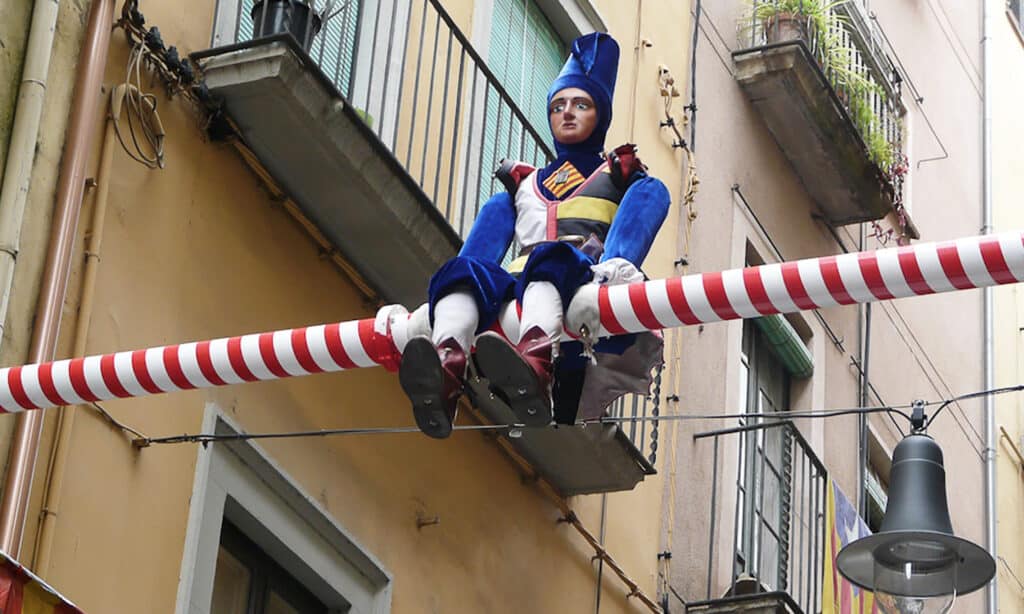
El Tarlà
This character is especially associated with Girona City and is basically a puppet, traditionally dressed as a jester. The story behind the puppet comes from the days when epidemics of the Plague were still terrifyingly common. When such an outbreak was detected in Carrer de l’Argenteria, a street with many silversmith workshops (hence the name), the street was blocked off at both ends using fences made of reeds in order to prevent the disease from spreading, effectively quarantining the residents.
Because quarantine was so boring – something we can now all relate to after events of recent years – a local character named Tarlà did his best to entertain his neighbours by performing somersaults and other acrobatic tricks in the street. Later, when the plague had passed, the locals put together a type of doll to try and recreate Tarlà’s acrobatics in his fond memory, and this puppet became a symbol for fun and partying in Girona and now bears his name.
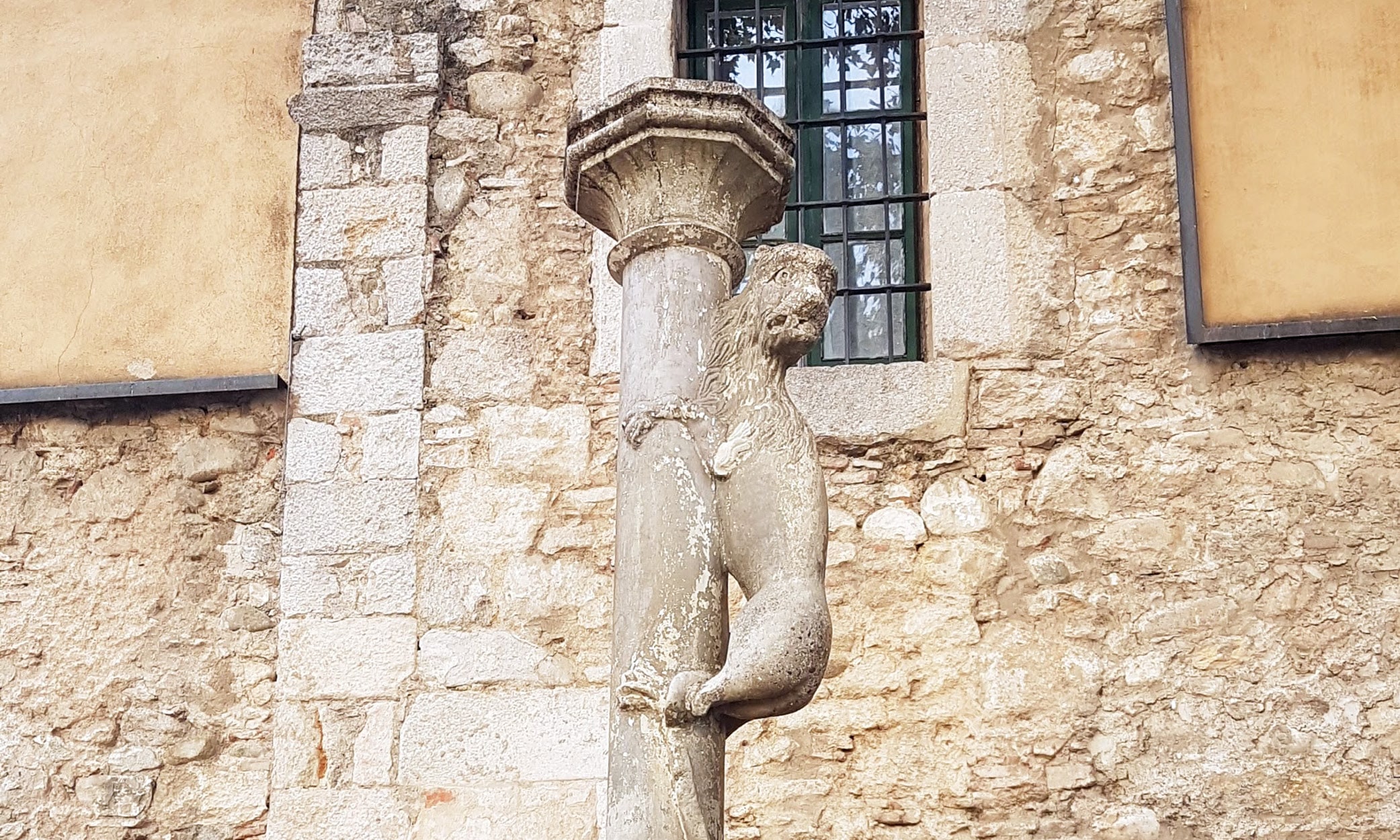
The Lioness’ Arse!
And finally, there’s the custom of kissing the backside of a statue of a lioness on Carrer dels Calderes! This one is pretty straightforward: if you kiss the lioness’ bum, it means that you will return to Girona city someday – or maybe that you might not leave at all! We recommend kissing it. What’s the worst that could happen?
Update: In February 2020, the Girona City Council, acting on advice from the Dept of Health, placed a fence around the lioness’ column. This was right at the start of the COVID-19 pandemic and was done in order to prevent people from kissing the lioness and risking spreading the virus. Since then, the fence has been removed, and so has the staircase that people used to climb up to kiss the statue. The City Council has said that they have no plans to put it back. So, no more lioness butt-kissing, for the foreseeable future at least. But we’re pretty sure you’ll want to return to Girona regardless!






